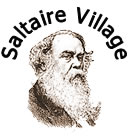Further reading:
Bert Thornton's own recollections of growing up in Saltaire as a lad >
Bert and Sheila Thornton have been important members of the United Reformed Church community for many years. The Thornton family history in the area began with Bert’s great grandfather, Anthony Thornton, was a manager at Dixon’s Mill, which was demolished to make way for the existing Salts Mill. The Thorntons preceded the Salts in the area!! Subsequently, Bert’s great grandfather, grandfather and father were all to work at Salts Mill.
Bert’s mother’s family, the Quanbury’s, originated in Market Deeping in South Lincolnshire, her grandfather being the village blacksmith. Rural poverty, and especially the potato famine, drove many families to seek work in the new industrialising areas of the North.
Bert’s own history began 89 years ago when he was born at 15, Shirley Street. Unfortunately, his father died when Bert was 18 months old, and his mother remarried. Bert was raised by his grandmother, Mary Jane Ridgeway. He attended Albert Road and Saltaire Road schools, before being selected, at 13 years old, to attend Shipley Selective Central School (now Shipley C/E School on Otley Road). At 15 years he joined an accountants firm in Bradford, and has remained in accountancy for the rest of his professional life. After the War, he re-joined Thoseby, Son and Co in Bradford, but his main period of employment was as accountant with a textile company at Bingley Mills (near to where Damart now stands in Bingley).
Bert’s Army career makes fascinating reading. He was injured on the football field (playing for Salts) on the day before his medical for joining up. His close friend passed the medical A1, and went on to be posted overseas in the trenches to be killed a few weeks later. Bert’s injury took him in a different direction, and he joined the Royal Army Medical Corps. He spent time in hospitals in Naburn near York, and in Iceland, where he was posted for 2.5 years. He nursed survivors of the “Hood” and “Prince of Wales”, both sunk by the “Bismark”. He was injured in the Normandy landings. He was “mentioned in dispatches” when a “doodle bug” exploded in Antwerp and he continued going back into the ruins to rescue people. One of his final postings was to Norway, where he was involved in the liberation of the country in May, 1945, and still has a certificate presented to him by King Haakon.
After the War in 1946, Bert returned to live with his grandmother on Shirley Street, buying the house for £250. They then moved out of the Village in 1947 onto Glenaire Drive, just off Coach Road. Marriage to Sheila came at this time. She originated in Ironbridge in Shropshire, and was a school teacher. In Yorkshire, she became a teacher at Linton Camp School in the Dales, and at Thackley Special School teaching “maladjusted” children. Finally she settled at Albert Road School where she remained from 1957 to 1983, rising to the post of deputy head teacher. She influenced a whole generation of Village children, including one of my own. They brought up 2 children here. Richard was with Customs and Excise until being injured in a car accident, and Brenda is now a missionary travelling throughout Latin America. Their two families have produced 5 grandchildren for Bert and Sheila.
Initially I mentioned their work at the Church. Bert was a teacher at the Caroline Street Sunday School (where the car park now is); was in the choir; was Church auditor; was an Elder; made a huge contribution to Scouting; and he and Sheila did much to open up the Church to the public – thus raising monies for the restoration. Bert still gives talks to schools about the Church and Village, and is to appear on a David Dimbleby programme on BBC TV next year. Unfortunately, illness has reduced Sheila’s involvement. Bert is her carer, but the past year he has been ill too. Despite this, this remarkable man keeps bouncing back, displaying a resilience and commitment to other people which should be an example to us all.
Another little snippet...
In 1992, vandalism at the Mausoleum led Sheila to clean the tiles there. Always having an eye for colour and design, she decided to investigate their origin. They had always been thought to be Italian. She and Bert returned to her native Shropshire and found that they had been made by Maws of Jackfield, Ironbridge – and they even found the original sales receipt to the Salt family.
Roger Clarke, June 2006

